Clinical Research & Data, Protected PCI
REVIVED-BCIS2 Interview: Gregg Stone and Divaka Perera
Percutaneous Revascularization for Ischemic Left Ventricular Dysfunction
Gregg Stone, MD, FACC, FSCAI interviews Prof. Divaka Perera, professor of cardiology at Kings College in London, UK at the European Society of Cardiology (ESC) Congress 2022 in Barcelona, Spain. Dr. Perera presented one of the most highly anticipated studies at this meeting, REVIVED-BCIS2, published in the New England Journal of Medicine.
REVIVED-BCIS-2 randomized 700 patients with severe left ventricular systolic dysfunction (LVEF<35%) and extensive coronary disease with demonstrable myocardial viability to receive percutaneous coronary intervention (PCI) or optimal medical therapy (OMT). In this initial publication of data, the authors concluded that among the patients who received OMT, revascularization by PCI did not result in a lower incidence of death from any cause or hospitalization for heart failure.
Key Topics Discussed:
- Part 1. REVIVED-BCIS2 Overview
Study background and design
Inclusion and exclusion criteria
Demographic and clinical patient characteristics
Primary and secondary outcomes
- Part 2. Deeper Dive into REVIVED-BCIS2 Patient Population
Ischemic burden questions
Impact of STICH trial results on clinical practice
NYHA classification and heart failure history of patients
Ejection fraction: echo core lab vs site findings
Impact of trial results on clinical practice
- Part 3. Implications for Revascularization and Upcoming Trials
Extent and completeness of revascularization in REVIVED-BCIS2
Number and management of chronic total occlusions (CTOs)
Impact of results on ongoing clinical trials (PROTECT IV and CHIP-BCIS3)
- Part 4. More Data and Analyses Yet to Come
MRI and angio core labs still processing REVIVED-BCIS2 data
ICD data to be presented at AHA if analyzed in time
Part 1: REVIVED-BCIS2 Overview
“We wanted to look at a stable cohort who were on medical therapy already,” Dr. Perera explains. “This was really designed to be a trial of prognosis, with the major patient-centric outcome of heart failure hospitalization… Most patients had NYHA I or II symptoms… Very few patients had angina. I would say two-thirds had no angina at all and in the remainder, the degree of angina they had was not limiting.” Looking at the primary outcome, Dr. Perera explains that around 38% of patients in both arms died or were hospitalized for heart failure. “That’s an unacceptable rate,” he states, “but there was no difference with PCI.” There was, however, a clear improvement in quality of life in favor of PCI at 6 months and at 12 months. In addition, Dr. Perera notes, “urgent unplanned revascularization was definitely higher in the optimal medical therapy arm.”
Part 2: Deeper Dive into REVIVED-BCIS2 Patient Population
“These results can’t be applied and extrapolated to a population that have a lot of angina,” Dr. Perera explains. After a deeper discussion of the REVIVED-BCIS2 patients and results, Dr. Perera tells Dr. Stone, “My practice is going to change.” He explains, “I would still offer revascularization to my patients who have angina, and I think that’s a very reasonable thing to do. There’s plenty of evidence that that’s good for them, for their quality of life… But what I won’t do after this trial, which I perhaps did do before, is to take a patient who’s stable, who has little or no symptoms, either breathlessness or angina, and say, ‘I can offer you a treatment which will make you live longer.’”
Part 3: Implications for Revascularization and Upcoming Trials
Reflecting on the impact of REVIVED-BCIS2 results on upcoming trials, Dr. Perera explains, “REVIVED was about the indication for revasc. CHIP BCIS-3 and PROTECT IV are about how we do the revasc and the indication decision has been made a little higher in the tree. And so far, based on my experience of patients who have gone into CHIP-BCIS3, they’ve largely been acute presentations, and less so, elective. And the elective ones have been for angina. So… I don’t think REVIVED is going to affect the clinical revasc of these patients, or the trials that will enroll them, too much, because they’re different issues.”
Part 4: More Data and Analyses Yet to Come
“We can’t give you all of the data, share all of the data yet,” Dr. Perera explains. MRI and angio core labs are still busily processing data. “The ICD data are going to be very interesting as well,” he notes. “So, remember, we’re looking at patients who died. But there are lots of patients whose death was aborted because of device therapy. So that’s a pre-specified analysis we’re going to do… and if we get it analyzed in time, we hope to share it at AHA.”
Sign Up for Latest Updates
NPS-3123


